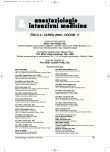Renal replacement therapy in critically ill patients: 2005 update
Podpora a náhrada funkce ledvin u kriticky nemocných – novinky roku 2005
Náhrada funkce ledvin je nutná u 50–70 % nemocných na JIP, u kterých došlo k rozvoji akutního renálního selhání (ARF) v rámci multiorgánového selhání s vysokou mortalitou (53–73 %). Je tedy zcela pochopitelný zájem kliniků vyvinout takovou léčebnou strategii, která povede ke snížení mortality kriticky nemocných s multiorgánovým selháním. Intermitentní hemodialýza umožní sice dobrou metabolickou kontrolu, ale je u hemodynamicky nestabilních hůře tolerována, zejména pak u septických nemocných. U septického šoku se mnohem častěji používají kontinuální očišťovací techniky pro jejich lepší hemodynamickou toleranci a také proto, že se ukazuje, že kontinuální hemofiltrace může zvrátit nepříznivý průběh sepsí indukované zánětlivé odpovědi, a to i v situacích, kdy nedošlo k ARF. V současné době se klade důraz na časné zahájení hemofiltrace u nemocných v sepsi. V klinických studiích se aktuálně testují nové postupy hemopurifikace u sepse (high-flux hemofiltrace, velkoobjemová hemofiltrace, hemoadsorpce). Zatím neexistuje přesvědčivý důkaz pro preferenci některé z modalit kontinuálních hemopurifikačních technik.
Klíčová slova:
akutní selhání ledvin – sepse – multiorgánové selhání – hemopurifikace – hemofiltrace
Authors:
I. Novák; M. Matějovič; A. Kroužecký; J. Raděj
Authors‘ workplace:
Jednotka intenzivní péče I. interní kliniky, Fakultní nemocnice a Lékařská fakulta UK, Plzeň
Published in:
Anest. intenziv. Med., 17, 2006, č. 2, s. 99-101
Category:
Intensive Medicine
Overview
Renal replacement therapy (RRT) is needed in 50% to 70% of patients with sepsis-related acute renal failure (ARF) in the ICU. The ARF in this setting is often accompanied by multiple organ dysfunction and is associated with very high mortality (53% to 73%). Thus, there is a great deal of interest in developing renal replacement strategies to reduce the mortality rate.Traditional intermittent haemodialysis in the treatment of ARF offers good metabolic control but poor haemodynamic tolerance, especially in septic patients. Haemofiltration is the more commonly used method in septic shock due to its better haemodynamic tolerance, and it is argued that haemofiltration can reverse the sepsis-related inflammatory response, even in the absence of ARF.This emphasises the potential role of the early initiation of haemofiltration in sepsis. Some new developments in blood purification for sepsis, including high-flux haemofiltration, high-volume haemofiltration, and the use of sorbents, remain under investigations. Current evidence is insufficient to draw strong conclusions regarding the method of RRT for ARF in septic patients.
Key words:
acute renal failure – sepsis – multiple organ failure – haemopurification – haemofiltration
Labels
Anaesthesiology, Resuscitation and Inten Intensive Care MedicineArticle was published in
Anaesthesiology and Intensive Care Medicine

2006 Issue 2
Most read in this issue
- Vasopressors in septic shock – 2005 update
- What’s new in the pharmacotherapy of pain?
- Renal replacement therapy in critically ill patients: 2005 update
- Echocardiography in the critically ill patient
